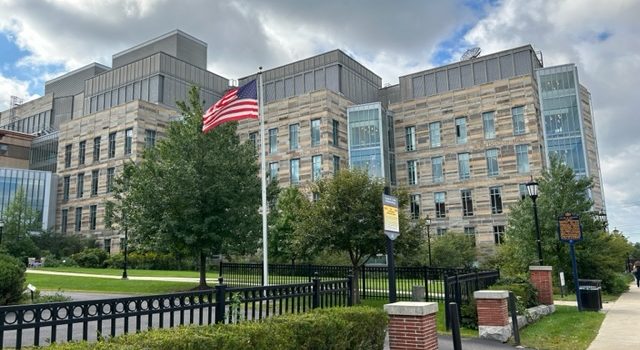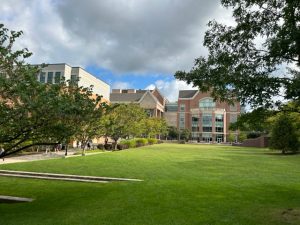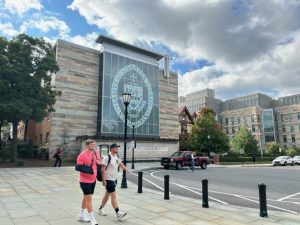Getting To Know: University of Scranton (PA)-Again
After I spent my day at Penn State to visit the Schreyer Honors College, I dropped by the University of Scranton. The University of Scranton is a Jesuit university, just like Boston College, Fordham and Georgetown, and like those schools welcomes students of all faiths. Yet it offers more merit-based aid than those schools, and starts at a lower sticker price. The university might undercut Home State U for the very best students and Selective Neighboring State U for many more. It has also gotten a mention in my book, The Good College.
My friend, Shannon Zottola, became Vice President of Enrollment Management at the university after serving in a similar role at Ursinus College, near Philadelphia. She and her team made me feel quite welcome on my third visit to this school .I also got to do something I have not done at other schools: talk to several students from New Jersey, my home state. College-bound students like to leave the Garden State, even though we have several attractive options. Thanks to Shannon and her team I really got to understand why the University of Scranton got on their lists.
Retention has slipped a little–most recently 87 percent–since the pandemic. But over three quarters of every class that entered from 2015 to 2018 graduated in four years. That’s better than any flagship state university in the Northeast, and equal to the College of New Jersey. Students also stick around to earn advanced degrees, especially in business, education and health-related fields. The policies towards AP/IB/dual enrollment credits are quite reasonable. High school students can also take classes at the University of Scranton through the university’s High School Scholars and Business High School Scholars programs.
The University of Scranton is smaller but mighty versus competing schools.
This school has approximately 3,600 undergrads. Admissions are not exceptionally selective. Eighty-four percent of applicants to the Class of 2026 were accepted, though admissions to nursing and the accelerated programs in the health professions will be more competitive. Admissions are test-optional for all majors, and it costs nothing to apply. The average GPA for the Class of 2026 was a 3.5. The middle 50 percent who submitted scores scored between 1150 and 1320 on the SAT and between 25 and 31 on the ACT. These numbers are below what you would find for schools such as Penn State or Rutgers-New Brunswick.
Students who look at the University of Scranton also considered versus larger schools, including:
- Fairfield University (CT): 4,800 undergrads
- Fordham University (NY): 10,000 undergrads
- Loyola University-Maryland: 4,000 undergrads
- Saint Joseph’s University (PA): 5,100 undergrads
- Seton Hall University (NJ): 6,000 undergrads
- The College of New Jersey-7,000 undergrads
- Villanova University: 7,000 undergrads
Aside from The College of New Jersey, which is public, the other schools are more expensive than the University of Scranton. The private universities also compete in NCAA D-1 varsity scholarship sports, Scranton is a D-3 non-scholarship school that has not played football since 1960. However, students are also quite engaged in intramural and club sports. The University of Scranton will also be considered against larger public universities such as Rutgers. The Scranton area is also close to Binghamton, home to the most selective campus in the State University of New York. But I felt that the students I met really wanted to go to a smaller school.
The University of Scranton is a very strong health science school vs.competitors for students
I used a site, College Results, to see how the University of Scranton compares with my list above for majors. Just under a quarter of degrees at the University of Scranton are in business, just over a fifth are in health sciences and 14 percent are in STEM subjects. Only Villanova, a far more selective school, has a similar balance of degrees. Fordham, Fairfield, Seton Hall and Loyola-Maryland granted larger percentages of business degrees. One difference in the health care offerings is the clinics offered to uninsured patients at the university’s Leahy Center, including physical therapy, low-vision care and counseling. The medical clinic will re-open in January, 2024 as a partnership with Geisinger Commonwealth School of Medicine.
This is less of a “spirit and sports” oriented place than a Big East or Patriot League school, and there is no Greek life.
However, the student community appears to be as service oriented as the students that I met at Villanova the week before. Further, unlike schools that place importance on Greek life and varsity sports. The University of Scranton does not appear to be a school with a dominant group that one “must join” to have a happy and successful educational experience. Clubs that might be selective at other schools such as investment clubs are more welcoming here. The university also operates a retreat center at nearby Chapman Lake for service activities and student clubs and organizations to meet. I also heard complements about the dining hall food and the on-campus housing, which you rarely hear about at other schools. These get mention in published rankings. But it was more valuable to hear confirmation from students you meet.
The University of Scranton has one of the most attractive campuses that I have seen at a city university.
I also dropped some photos of the campus up top and below. The Loyola Science Center, in my view, is the signature building. Whether you major in a science, or anything else, you would likely have at least one class in this building and you will visit the career center in there. The newest academic facilities on campus, the DeNaples Student Center and the student apartments rival anything that you are likely to see at larger schools. I hope that you will check out my photos of the campus on Pinterest.
It’s easy to walk downhill into downtown Scranton.
The city has coffee shops and restaurants affordable to student budgets as well as a calendar of downtown festivals. One of the largest, La Festa Italiana, takes place over Labor Day weekend, and draws over 150,000 people downtown. However, while the city has these amenities, it is not a college town in the same manner as State College, home to Penn State, where dining and entertainment remain open very late. But among the Jesuit schools I have visited only Fordham and Loyola-Chicago offer easier access to a festive urban environment.
Scranton, the city, is much smaller than Boston, New York or Washington DC.
With a population of over 76,000, Scranton is the sixth-largest city in Pennsylvania. It’s also the birthplace of President Joe Biden, though his family moved to Delaware when he was 11. Nicknamed the “Electric City’ because it was one of the first cities to have electric trolley cars, Scranton was the most important coal and steel town in the America after Pittsburgh. It was also a major railroad hub for the Northeast. However, the trolleys and the major industries ceased operations by the early 1970’s. Health care is a dominant industry in the metro area as is tourism. Scranton was also the fictional home for The Office, a sitcom about working life, that ran on NBC from nine seasons from 2005 to 2013. I watched some YouTubes about the city and learned that local businesses and tourist attractions continue to promote on the city’s association with the show.
There are many attractions in the Scranton-Wilkes Barre area, such as Montage Mountain and shopping in nearby Dickson City. The RailRiders, the New York Yankees top minor league team, play near campus, and the NHL Pittsburgh Penguins minor league team plays nearby in Wilkes-Barre. The campus is also close to many opportunities for hiking and outdoor recreation. Amtrak has conducted studies about reviving passenger train service from Scranton to New York City, and believes that service is feasible. However, students and residents interested in traveling to New York or Philadelphia today will need to rely on cars or buses for now. The university helps students to get to local attractions and the cities,, but it really helps to have access to a car after freshman year.
Conclusions
The University of Scranton does what a very good school should do: provide a strong academic and career direction for the students it attracts to campus, and guide them successfully to graduation and life after college. It’s really tough for me to fault the school, though it does not appear to be terribly well known outside of Pennsylvania and neighboring states. The University of Scranton is classified as a Regional University in US News rankings–it’s #5 in the North–while more selective Jesuit and Catholic universities are listed in national rankings with larger research universities.
This school has large alumni communities within the Baltimore/Washington Corridor, New York and Philadelphia as well as Northeastern Pennsylvania to support students in their searches for internships and full-time jobs. Students who live in the Mid-Atlantic region who might get into a flagship state university or a school such as Drexel or Syracuse, but would prefer a smaller school, should put the University of Scranton on their visit lists.
Report Card: University of Scranton
- Four-Year/Six-Year Graduation Rates: A/A
- Freshman Retention: B+
- Costs: B+
- Curriculum: A
- Community: B+
- Comforts: A
- Connections: B+ (Mid-Atlantic states)/C (elsewhere)
Want to know more about me?
Buy my new book, The Good College!
Listen to my latest interview on ‘Tests and the Rest’ with Amy Seeley and Mike Bergin!
Check out my talk, What Exactly Is a Good College? hosted by test-prep experts Amy Seeley and Mike Bergin on Tests And The Rest!
Listen to my talk, College Is A Learning AND Living Community hosted by Dr. Cynthia Colon from Destination YOUniversity on Voice of America Radio!
Sharing is caring!




